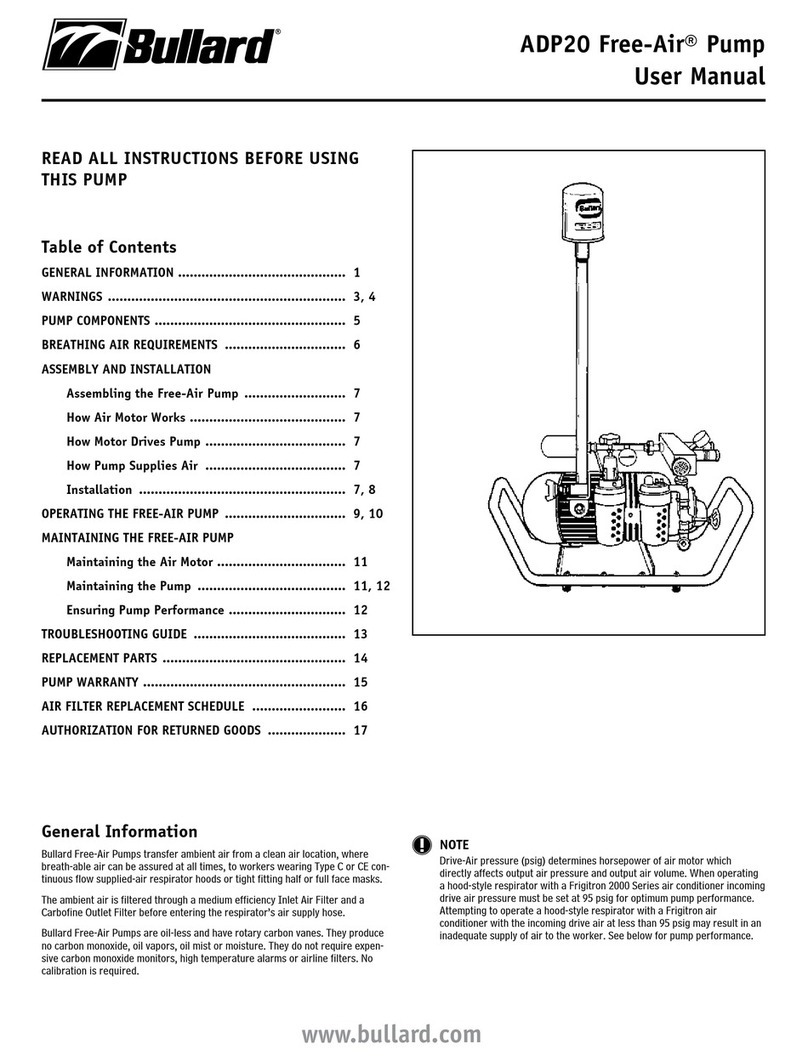
ICE Pump
User Manual
5
Maintenance and Inspection
Maintenance and Inspection
If pump or motor show evidence of overheating, or is excessively
noisy, stop immediately for repairs. Regular inspection can prevent
unnecessary damage and repairs. The rider thickness can be an
indication of when rings need replacing. If a rider ring measures
.055” or less in thickness, a change of all rings should be made. For a
unit operated at sea level in fairly clean air at an ambient of 65-75ºF
relative humidity of approximately 35%, and at maximum advertised
duties, it is suggested that 4,000 hours of operation be used as an
initial inspection point. As operating conditions on your particular
application improve or worsen, your own experience can be used to
determine whether this 4,000 hour figure can be lengthened or should
be shortened.
Filter Inspection and Replacement
The inlet filters and outlet filters require periodic inspection and
replacement. Initial inspection is suggested at 500 hours. Then,
the user should determine the frequency. Most problems can be
prevented by keeping filters clean. Dirty filters decrease pump
performance and can decrease pump service life.
Make sure the pump is turned off and isolated from the power supply
and all pressure and vacuum is released from the pump.
Remove inlet filter cover and inspect filter felt. If the felt is completely
covered with contamination or has indicated an increase in differen-
tial pressure, it must be replaced. Replace felt and install filter cover.
Before putting the pump back into service, ensure that any external
accessories such as relief valves and gauges have not been damaged.
NOTE
NEVER LUBRICATE THIS OIL-LESS PUMP. THE MOTOR BEARINGS
ARE GREASE PACKED AND SEALED. THEY REQUIRE NO FURTHER
LUBRICATION.
ICE Pump Trouble Shooting Guide
If your Bullard ICE pump is not working satisfactorily, please follow the
trouble shooting steps below:
Initial Checklist
1. You must use at least 100 feet of air supply hose for ICE Pumps,
per your respirator’s approved assembly. Any shorter length of
hose could cause back pressure and low air flow to user.
2. If using an extension cord, Bullard recommends 20 amp, 3-wire, 10 AWG
grounded extension cord up to 100 feet. Do not overload the circuit with
additional electrical equipment. The ICE pump requires at least a 12 kw
generator.
3. If using a Bullard cool tube, only the FRIGTRON2000 is approved for
the ICE pump. The AC1000 may also be used only when combined
with the Bullard Spectrum full facepiece, V10 hose, and a V15FT
1/4" Quick Disconnect coupler.
SYMPTOM: Pump Fails to Start or Hums
1. Turn pump switch off and disconnect from the power source.
2. Check for the correct electrical current as shown on the motor plate and
in the Electric Motor Specification Chart on page 3 of this manual.
3. The pump is equipped with a thermal overload protector that turns the
current off when subjected to electrical overloads. Check to be sure that
the circuit is not overloaded by the pump and other electrical equipment.
4. Check to make sure that the pistons move freely. If not, service kit for
piston rings may be necessary.
5. Wait 15 minutes and restart.
SYMPTOM: Outlet Air Pressure Too Low
1. Be sure you know the proper pressure range for the respirator - see
the respirator’s instruction manual.
2. Be sure the respirator and air supply hose are connected when the
gauge reading is taken.
3. Check to see that the gauge is functioning properly. Replace the gauge
if broken or malfunctioning.
4. Check for blockage of 90 micron inline outlet filter.
5. Check to see that no air is escaping from the relief valve on pump.
6. Check that both the inlet filters (Cat. No. 23611 ) and outlet filter
(Cat. No. ICEOF) are clean and replace if necessary. Dirty filters
restrict air flow.
7. Make sure there is nothing obstructing the airline supply hose.
SYMPTOM: Outlet Pressure Too High
1. Ensure there isn’t added back pressure on the ICE pump - high
pressure on the outlet pump gauge will occur. Be sure the outlet
pressure remains in the proper range for the respirator as specified
by the respirator manufacturer. See the respirator’s instruction
manual.
2. Check the respirator’s air supply hose for kinks.
3. Ensure that breathing air supply hose is not a shutoff. Back pressure
can damage pump when no respirator is connected.
SYMPTOM: Pump Overheating
1. 160° - 200°F (80° - 120°C) is normal output air temperature when
the pump is continuously running. This heat is dissipated as it
travels through the respirator’s air supply hose until it reaches
ambient air temperature.
2. Make sure that both the inlet and outlet filters are clean. Replace if
necessary.
3. Be sure the outlet pressure remains in the proper range for the
respirator as specified by the respirator manufacturer - see the
respirator’s instruction manual.
4. The electrical circuit to which the pump is connected is overloaded.
Check the amperage load of the circuit and disconnect other
electrical equipment, if necessary, from that circuit.
5. Ensure that breathing air supply hose is not a shutoff. Back pressure
can damage pump when no respirator is connected.
www.bullard.com

































